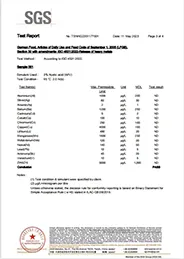
how to properly season cast iron skillet
How to Properly Season a Cast Iron Skillet
Cast iron skillets are beloved by cooks around the world for their versatility, durability, and ability to retain heat. However, to maximize their performance and longevity, it’s essential to season them properly. Seasoning not only creates a non-stick surface but also protects the skillet from rust and enhances the natural flavor of the food cooked in them. In this article, we’ll walk you through the steps to properly season a cast iron skillet and share some tips to maintain that perfect seasoning.
What Is Seasoning?
Seasoning is the process of applying a layer of fat or oil to the surface of the cast iron skillet and then heating it to form a hard, protective layer. This layer of polymerized oil adds a natural non-stick property to the skillet and protects it from moisture, which can cause rust. Over time, with regular use and maintenance, the seasoning on your skillet improves, making it even more effective.
Step-by-Step Guide to Seasoning Your Cast Iron Skillet
Step 1 Gather Your Materials
Before you begin, gather the necessary materials - A clean cast iron skillet (new or previously used) - Mild dish soap (for the initial cleaning) - A scrub brush or steel wool - Cooking oil (flaxseed oil, vegetable oil, or canola oil work well) - Paper towels - An oven set to 450°F (232°C)
Step 2 Clean the Skillet
If your skillet is new, it might have a factory coating that needs to be removed. For used skillets with leftover residues, follow these steps
1. Wash with Soap Begin by scrubbing the skillet with warm water and mild dish soap. Use a scrub brush or steel wool to remove any sticky or burnt remnants. It’s a common myth that you shouldn’t use soap; however, for the first cleaning, it’s necessary. 2. Rinse and Dry Rinse the skillet thoroughly with hot water and dry it completely with a towel. Alternatively, you can place it on the stovetop over low heat to ensure all moisture evaporates.
Step 3 Apply Oil
Once the skillet is clean and dry, it’s time to apply the oil
1. Choose Your Oil Opt for oils with high smoking points. Flaxseed oil is often recommended for its ability to create a durable finish. However, vegetable oil or canola oil is also suitable.
2. Apply a Thin Layer Pour a small amount of oil onto a paper towel and wipe it over the entire surface of the skillet. Make sure the coat is very thin; too much oil can result in a sticky surface after seasoning. The goal is to have a light sheen on the skillet.
how to properly season cast iron skillet

Step 4 Bake the Skillet
Now that the oil is applied, it's time to bake the skillet
1. Preheat the Oven Set your oven to 450°F (232°C) and allow it to preheat.
2. Position the Skillet Place the skillet upside down on the top rack of the oven. This prevents excess oil from pooling in the pan. You can place a baking sheet or aluminum foil on the bottom rack to catch any drips.
3. Bake for an Hour After the oven reaches the desired temperature, bake the skillet for one hour. This process will polymerize the oil, creating a hard, protective layer.
4. Cool Down After an hour, turn off the oven and allow the skillet to cool inside. This gradual cooling helps to cure the seasoning effectively.
Step 5 Repeat if Necessary
For new skillets or those that have not been seasoned in a while, you might want to repeat the oil application and baking process 2-3 times. This builds up a stronger seasoning layer that enhances the skillet’s performance.
Tips for Maintaining Your Seasoning
- Avoid Soap Post-Seasoning Once your skillet is well-seasoned, avoid using soap to clean it. Simply rinse it with hot water and use a soft scrub brush if needed. - Dry Immediately After washing, dry the skillet immediately to prevent rusting.
- Apply Oil After Use After cleaning, apply a light coat of oil to keep the surface conditioned.
- Store Properly Store your skillet in a dry place. If stacking with other cookware, place a paper towel between the skillets to absorb moisture.
By following these steps, you can ensure that your cast iron skillet remains a treasured tool in your kitchen for years to come. With proper seasoning and care, your skillet will not only perform better but also enhance the flavors of your favorite recipes. Happy cooking!
-
Season Cast Iron Perfectly with GPT-4 Turbo TipsNewsAug.01,2025
-
High Quality Cast Iron Cookware - Baixiang County Zhongda MachineryNewsAug.01,2025
-
Premium Cast Iron Pan: Durable & Perfect HeatNewsAug.01,2025
-
High Quality Kitchen Durable Black Round Cast Iron Cookware Pancake Crepe Pan-Baixiang County Zhongda Machinery Manufacturing Co., Ltd.NewsAug.01,2025
-
Cast Iron Cookware - Baixiang County Zhongda Machinery | Nonstick, Heat ResistanceNewsAug.01,2025
-
High Quality Kitchen Durable Black Round Cast Iron Cookware - Baixiang County Zhongda Machinery | Non-Stick, Heat Retention, DurableNewsJul.31,2025


